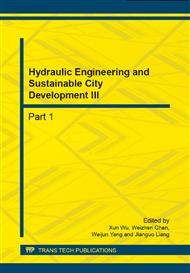[1]
Xiaonan Gong. Soil mechanics[M]. Beijing: China Architecture Industry Press, 2005. (in Chinese).
Google Scholar
[2]
RICHARDS K S, REDDY K R. True triaxial piping test apparatus for evaluation of piping potential in earth structures[J]. Geotechnical Testing Journal, 2010, 33(1): 1 - 13.
DOI: 10.1520/gtj102246
Google Scholar
[3]
Sellmeijer J. B. Piping due to flow towards ditches and holes[A]. Proceedings of Euromech [C]. 143, Delft, 1981, 69 - 72.
Google Scholar
[4]
Changxi MAO, Xiangbao DUAN, Jinbang CAI. Experimental study on piping development control by means of suspended cut-off wall[J]. Journal of Hydraulic Engineering, 2005, 36(1): 42 - 50. (in Chinese).
Google Scholar
[5]
STERPI D. Effects of the erosion and transport of fine particles due to seepage flow[J]. International journal of Geomechanics, 2003, 3(1): 111 - 122.
DOI: 10.1061/(asce)1532-3641(2003)3:1(111)
Google Scholar
[6]
Usama EI Shamy, and Firat Aydin. Multiscale modeling of flood-induced piping in river levees. Journal of Geotechnical and Geoenvironmental Engineering, 2008, 134(9): 1385-1398.
DOI: 10.1061/(asce)1090-0241(2008)134:9(1385)
Google Scholar
[7]
Xiaodong NI, Yuan WANG, Fei WANG. Study on Piping by Sand-bank Model And simulation by PFC3D [J]. Journal of Sichuan University(Engineering Science Edition), 2009, 41(8): 51 - 57. (in Chinese).
Google Scholar
[8]
Changxi MAO, Xiangbao DUAN, Jinbang CAI, et al. Piping experimental study and theoretical analysis of unsteady seepage flow during flood peak [J]. Journal of Hydraulic Engineering. 2005, 36(9): 1105-1120. (in Chinese).
Google Scholar
[9]
Yuan WANG, Qingqing YAN. PRIMARY RESEARCH OF INFLUENCE OF UNSTEADY SEEPAGE PROCESSES ON HYDRAULIC FRACTURING IN ROCK MASS [J]. Chinese Journal of Rock Mechanics and Engineering, 2012, 31(10): 2016-2021. (in Chinese).
Google Scholar
[10]
Jian ZHANG, Jianfeng ZHAI, Xianmei WANG, et al. Analysis of piping field distributions based on unsteady spherical well flow theory [J], HYDRO-SCIENCE AND ENGINEERING, 2014, (1): 49-55. (in Chinese).
Google Scholar
[11]
Yifeng CHEN, Ran HU, Chuangbing ZHOU, et al. A new parabolic variational inequality formulation of signorini's condition for non-steady seepage problems with complex seepage control systems[J]. International Journal for Numerical and Analytical Methods in Geomechanics, 2010, DOI: 10. 1002/nag. 944. (in Chinese).
DOI: 10.1002/nag.944
Google Scholar
[12]
Tongkang Tao. Experiment Study and Computation of Unsteady Seepage in Embankment Dams[J], 1981, 3(1): 81-93. (in Chinese).
Google Scholar
[13]
Peiwen ZHANG, Defu LIU, Dahai HUANG, et al. Saturated-unsaturated unsteady seepage flow numerical simulation[J]. Rock and Soil Mechanics, 2003, 24(6): 927–930. (in Chinese).
Google Scholar
[14]
Houxiang LIU, Ning LI, Xue LIAO, et al. Unsteady seepage analysis of tailing dams considering coupling of stress and seepage fields[J] . Chinese Journal of Rock Mechanics and Engineering, 2004, 23(17) : 2870-2875. (in Chinese).
Google Scholar
[15]
Dean, E.T.R. Discussion on Scale-modeling of fluid flow in geotechnical centrifuges[J]. Soils and Foundations, 2001, 41(4): 108 - 110.
Google Scholar
[16]
N.I. Thusyanthan. Scaling of Seepage Flow Velocity in Centrifuge Models[J]. CUED/D -SOILS / TR326, 2003, 1 - 13.
Google Scholar


